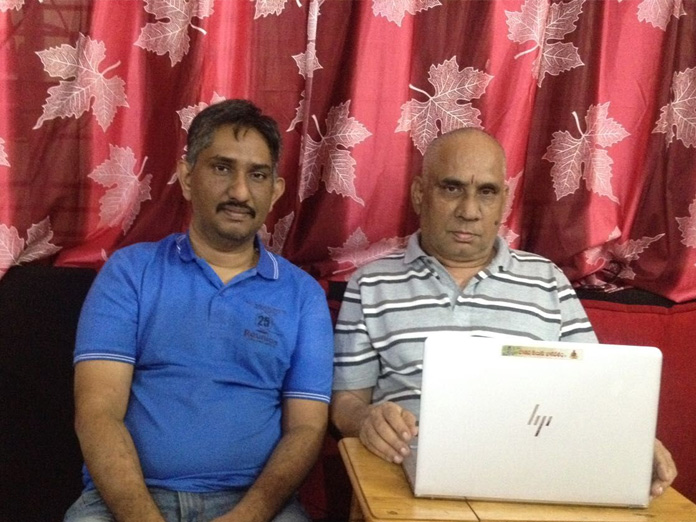A labour of love

The Srimad Bhagavatam, a religious, philosophical and literary classic written in the Puranic tradition as the profound essence of the Vedas by the learned sage Veda Vyasa, has often been compared to the ripened fruit of the tree of Vedic literature It is the most complete and authoritative exposition of Vedic knowledge covering a wide array of subjects that include aspects ranging from the kno
The ‘Srimad Bhagavatam’, a religious, philosophical and literary classic written in the Puranic tradition as the profound essence of the Vedas by the learned sage Veda Vyasa, has often been compared to the ripened fruit of the tree of Vedic literature. It is the most complete and authoritative exposition of Vedic knowledge covering a wide array of subjects that include aspects ranging from the knowledge of the self to the creation of the universe. On par with the Upanishads and the Bhagavad Gita and referred to as the fifth Veda it is considered a supreme work impacting spiritual aspirants traversing the path of love and devotion. Sri Ramakrishna Paramahamsa has therefore described stories from the Bhagavatam as ‘fried in the butter of knowledge and steeped in the honey of love’.
Vyasa’s phenomenal work in Sanskrit translated into Telugu by the 15th-century poet Bammera Pothana became hugely popular for its literary style and content and came to be known as ‘Pothana Bhagavatam’. Said to have been written on Lord Rama’s instructions as evident from the words ‘Palikinchedivadu Ramabhadrundata’ (It is Rama who speaks through me) Pothana’s work laced with devotion and ‘Sharanagata Bhava’ (total surrender) is considered to be among the brightest gems of Telugu literature. The desire to make Pothana’s work easily understood and available at all times led to a website and the Telugu Bhagavatam app developed as a labour of love, by Voolapalli Sambasiva Rao a retired engineer from the electricity department.
“Simple verses full of enchanting phrases, profound emotion, majestic grace and skilful use of similes and metaphors define Pothana’s work which can be appreciated both by the scholarly and the uninitiated. As a lover of literature and the lyrical beauty of the Telugu language I undertook the task of providing the word to word meaning and summary of each of the 9013 poems along with the audio rendering,” says Sambasiva Rao, who began work on the project in July 2007 after his retirement from government service. The work was long drawn as Rao provided the grammatical context for each poem (Kanda, seesa and others as per the rules of grammar) and also what is called ‘tippani’ where the origin of words is explained. For example, explaining words like ‘Padmakshudu’ a reference to Vishnu derived from Padma (lotus) and Akshu (eyes) to mean the Lotus-eyed-one and other similar words was done with allusions to deeper significance known as ‘Nigoodaardham’.
The 12 chapters or Skandas of the Bhagavatham have many stories with the liberation of the soul as the ultimate goal, says Sambasiva Rao, who studied varied interpretations which he accommodated in his version. “In my summary, I have explained poems elaborately linking them to management techniques and other skills that we need in our day to day life. I have explained the story of Pruthu Chkaravarthi who faces famine and deals with mother earth in this context. Similarly, all modules like the ‘Gajendra Moksham’ and ‘Rukmimi Kalyanam’ are complete by themselves and can be read as individual modules as well as in continuity,” he explains.
Rao’s ‘Bhagavatha Ganadhyaayee’ the app which can be freely downloaded and accessed and the website http://telugubhagavatam.org was put together by his son Fani Kiron, a software expert based in Bengaluru. “This has been a combination of ‘Sahityam’ (literature) and ‘Sankethikam’ (technology) where the latter brings the former within the realm of all,” he adds crediting his son for the effort.
The website has some 40,000 hits and the app that was officially launched at the Ganesh temple in Bengaluru’s HSR Layout in 2016 has 68,700 downloads until now. The app is useful as people can access it on their mobiles, reading up whenever they have the time or during travel making it an invaluable read. Like Pothana, who refused to dedicate his book to the king who was a mere mortal, preferring to set it at the lotus feet of Lord Rama, Rao too brings out his work without expecting any commercial benefit but the satisfaction of spreading Pothana’s great work.
“I want the work to be read and appreciated by the younger generation as Bhagavatam is replete with invaluable life lessons woven in a story form,” he explains. “Mandara makaranda madhuryamuna delu madhupambu bovune madanamulaku?” (How can a honey bee that has tasted the nectar of the ‘makaranda’ flower be attracted to grass flowers, however, attractively coloured they may be?) asks Pothana, in the poem where Prahlada through several examples concludes that one who has the good fortune of knowing the greatness of Hari can look towards no other. Pothana’s nectar like Bhagavatam is there to be enjoyed at no cost thanks to over nine years of painstaking effort. All it requires is the will to experience its sweetness.



















